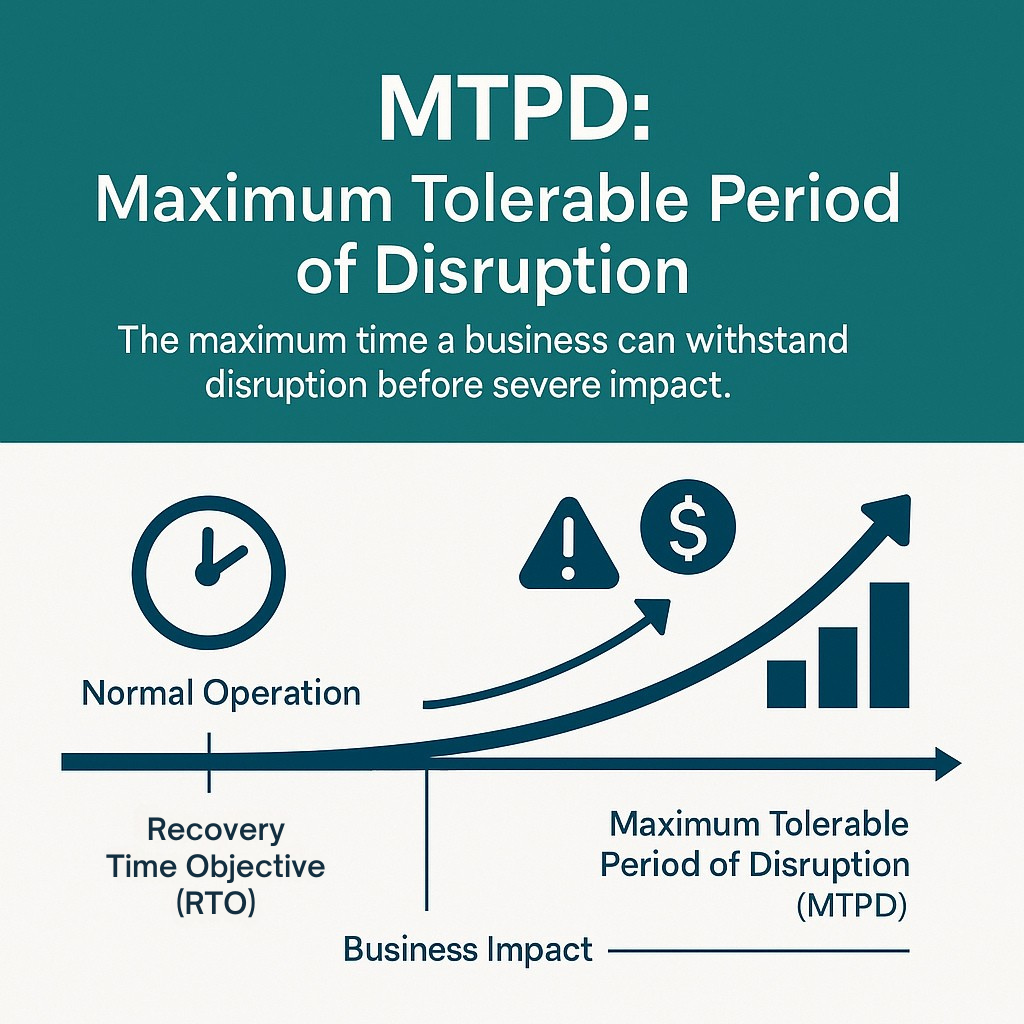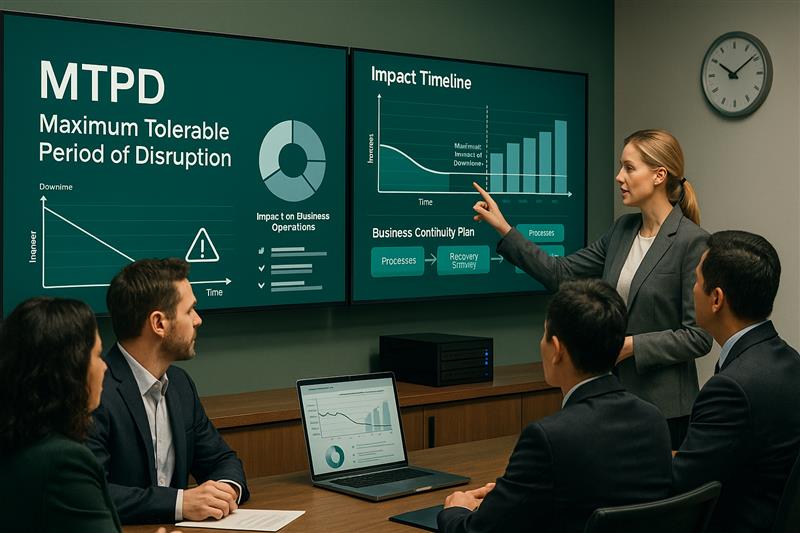In an era where businesses constantly face uncertainty whether from natural disasters, cyber security incidents, fires, or economic crises. One thing organizations cannot overlook is “preparedness” to ensure operations can continue even in the face of unexpected events.
A Business Continuity Plan (BCP) has therefore become an essential tool that every organization should have. But before effective planning can take place, it is crucial to understand a core concept: MTPD, Maximum Tolerable Period of Disruption, also known as Maximum Tolerable Downtime or Maximum Tolerance Outage. This refers to “the maximum duration a business can tolerate disruption without risking its survival.”
Understanding MTPD correctly not only helps you design a targeted BCP, but also enhances the effectiveness of operations under a Business Continuity Management System (BCMS), in alignment with international standards such as ISO 22301.
HIGHLIGHTS:
- MTPD is the maximum duration an organization can tolerate disruption (Maximum Tolerable Downtime).
- RTO must be shorter than MTPD to ensure business recovery before reaching a critical point.
- MTPD is derived from BIA analysis and risk assessment.
- Understanding MTPD helps organizations manage risks effectively across all dimensions.
What is MTPD?

Maximum Tolerable Period of Disruption (MTPD) refers to “the maximum duration an organization can tolerate when a critical process is disrupted without causing severe or irreversible impact to the business.”
In other words, if an organization must temporarily halt operations, the MTPD helps answer the question: “How long can we afford to stop?” before the consequences become too severe to recover from, such as loss of revenue, customers, or facing legal action.
In BCP planning, MTPD is often used alongside the Recovery Time Objective (RTO), which is “the targeted time within which systems or processes should be restored.” The key principle is that RTO must be less than or equal to MTPD, but in most cases, RTO should be shorter than MTPD to ensure the business resumes operations before reaching a critical threshold that threatens its survival.
The importance of MTPD in BCP

Defining MTPD is a crucial step in the BCP planning process, as it enables organizations to:
- Clearly identify and prioritize critical activities.
- Design appropriate recovery strategies for each system, such as incident response or crisis management.
- Manage resources and budgets efficiently without unnecessary investment
- Establish a timeframe for BCP exercises to assess the organization’s actual readiness.
For example, in a manufacturing plant, MTPD refers to the maximum time the production line can be halted before it affects product quality or delivery schedules. Each process may have a different MTPD. For instance, production may only tolerate a few hours of downtime, while support functions may withstand a full day. Properly defining MTPD helps the plant plan its BCP and manage risks effectively.
The Difference Between MTPD vs. RTO
When an organization plans its BCP, two key questions must be answered: “How long can our business afford to stop?” and “By when must operations be restored?” These two questions are directly related to MTPD and RTO.
MTPD and RTO are often discussed together, but they have distinct meanings and roles. Understanding the difference between them helps organizations respond to disruptions more accurately and prioritize recovery efforts more effectively.
Difference
MTPD
(Maximum Tolerable Period of Disruption)
RTO
(Recovery Time Objective)
Definition
The maximum duration an organization can tolerate disruption without causing serious impact to the business.
The targeted time within which the organization aims to recover processes or systems and resume operations.
Objective
Used to define the “maximum limit” of disruption
Used to define the “recovery objective” to resume operations before reaching a critical point.
Usage in BCP Planning
Derived from Business Impact Analysis (BIA) to determine how much loss is acceptable
Derived from Business Impact Analysis (BIA) or Disaster Recovery Planning (DRP) to ensure recovery is achieved within the defined timeframe
Relationship Between MTPD and RTO
MTPD represents the maximum threshold a business can tolerate for disruption.
RTO should be shorter than MTPD to ensure systems are restored before actual impacts occur.
Example
In a manufacturing plant, an MTPD of 8 hours means the production line can be halted for no more than 8 hours.
Setting an RTO of 4 hours means the production process must be restored and operational within 4 hours.
MTPD is “the duration a business can tolerate”, while RTO is “the time by which recovery must be achieved” to prevent business impacts from escalating beyond control.
Frequently Asked Questions (FAQs)
What is MTPD, and how can we determine it for our organization?
Start by conducting a risk assessment and Business Impact Analysis (BIA) to evaluate how disruptions affect revenue, customers, or legal obligations. If you’re unsure how to calculate MTPD or conduct a BIA, you can learn through InterRisk’s BCP training courses.
Why define MTPD for every process? Can we use a single average value for the whole organization?
Using an average is not recommended because each system has different levels of importance. For example, the impact of disruption in production is not the same as in accounting.
How should MTPD be appropriately defined?
It should be based on the principle of “balancing risk and cost”, using data from BIA and risk assessments.
What’s the difference between MTPD and RTO?
MTPD is the maximum limit, while RTO is the recovery target. And RTO must always be shorter than MTPD.
How can we verify if our MTPD is accurate?
By conducting testing and BCP exercises, such as simulating a real system failure to assess whether recovery can be achieved within the set timeframe. If not, the plan must be revised or resources increased.
Who is responsible for defining MTPD?
Typically, it’s the responsibility of each department managing Operational Risk Management, in coordination with the risk management team and executive leadership to ensure alignment with Enterprise Risk Management.
If we don’t have a BCP yet, where should we start to define MTPD?
Begin with a basic BIA and risk assessment, then design contingency plans for critical processes.
Does MTPD need to be updated frequently?
It should be reviewed at least once a year, or whenever there are organizational changes, such as new IT systems or changes in supply chain risk management.
Is there an automatic tool to calculate MTPD?
There is no automated tool or fixed formula, but you can use frameworks from ISO 22301 and guidelines from InterRisk to calculate it appropriately.
How can we get expert help to analyze MTPD?
You can start by requesting a pre-assessment consultation from InterRisk Asia, which will help identify critical processes and calculate a suitable MTPD for your business.
MTPD is the foundation of BCP planning that businesses should not overlook. Discover your MTPD with InterRisk Asia
MTPD is a fundamental element of Business Continuity Planning (BCP) and a core concept in Business Continuity Management (BCM). It helps organizations understand “how long they can afford to stop and when they must recover” to prevent damage from unexpected events.
InterRisk Asia, a consulting firm under the MS&AD Group from Japan, offers comprehensive BCM services. These include risk assessment, BCP development, BCP training, BCP exercises, and end-to-end consulting across various industries. We help organizations analyze and define appropriate values for RTO, RPO, and MTPD, ensuring business continuity even in the most challenging situations.
End-to-end consulting for the development of a robust BCMS, with pathways to ISO 22301 certification
Specialized training programs designed for both management and staff to enhance awareness and competency in BCMS practices.
Analysis of operational risks and disruption impacts to inform the development of targeted continuity strategies.
Structured exercises to validate your BCP and strengthen organizational preparedness and response capabilities.
Experienced consultants with hands-on BCMS expertise
Customized planning tailored to your business context.
Practical tools and templates, with expert support for testing and improvement.

